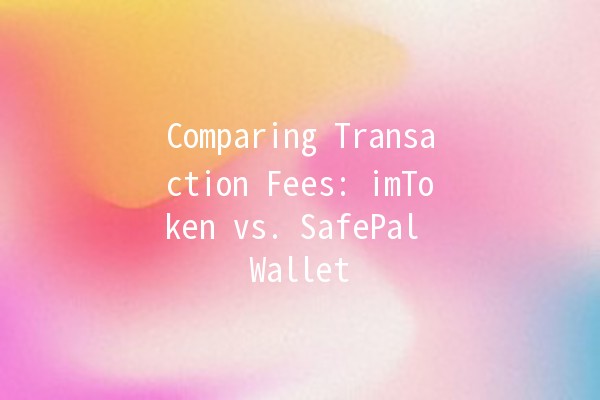In the vibrant industry of cryptocurrency, choosing the right wallet is crucial for both security and costefficiency. Two popular mobile wallets, imToken and SafePal, have gained significant traction among users. One of the most pressing considerations for any crypto enthusiast are the transaction fees associated with each wallet. In this article, we will delve into a comprehensive comparison of the transaction fees for imToken and SafePal, along with practical insights and productivityenhancing tips that can optimize your crypto transactions.
Transaction fees are the costs incurred when transferring cryptocurrencies from one wallet to another. These fees can vary significantly based on factors like network congestion, the type of cryptocurrency being transacted, and the platform being used to facilitate the transaction. Both imToken and SafePal offer different fee structures and dynamics.

Network Fees: Every transaction requires a fee paid to miners or validators who confirm transactions on the blockchain. This fee fluctuates depending on network traffic.
Wallet Fees: Some wallets may impose their own fees on top of network fees, although many innovative wallets strive to keep these as low as possible to attract more users.
Currency Type: Transaction fees may vary based on the cryptocurrency being sent. For example, Ethereum transactions generally involve higher fees than Bitcoin due to network demand and complexity.
imToken is a wellestablished wallet in the crypto space, particularly popular among Ethereum and ERC20 token users. It stands out with a userfriendly interface and robust security features.
Monitor Network Activity: Use resources like Etherscan to monitor network congestion and adjust transaction fees accordingly.
Optimize Fees by Timing: Conduct transactions during offpeak hours when network congestion is lower, often resulting in lower fees.
The user experience with imToken is generally smooth, with an intuitive interface that allows users to track their fees dynamically before finalizing a transaction.
SafePal is known for its comprehensive security measures and support for a wide range of cryptocurrencies, making it a compelling option for diverse crypto users.
Utilize Fee Recommendations: Follow the wallet’s fee recommendations, especially during high traffic times, to avoid excessive charges.
Timing Your Transactions: Similar to imToken, choosing to transact during less busy times can lead to substantial savings on fees.
SafePal’s interface provides realtime tracking of transaction fees and allows users to customize their transaction preferences effectively, making it userfriendly despite the multitude of features it offers.
| Feature | imToken | SafePal |
||||
| Fee Type | Network fees only | Network fees only |
| Fee Customization | Yes | Yes |
| Transparency | High | High |
| Recommended Fee Visibility | Yes | Yes |
| User Experience | Smooth and intuitive | Featurerich, straightforward|
To further enhance your cryptocurrency transaction experience and keep costs down, consider the following strategies:
Batching your transactions can significantly reduce the number of fees incurred. For example, if you need to transfer cryptocurrency to multiple wallets, batch them into a single transaction when possible. This approach minimizes the total network fees paid.
Leverage networks that provide the best fee structure for specific transactions. For example, if transferring ERC20 tokens, consider using layer2 solutions like Polygon, which can offer lower fees compared to Ethereum's main net.
Stay aware of market trends by setting up fee alerts that notify you when transaction costs drop. This knowledge allows you to time your transactions for maximum savings effectively.
Maintain a routine of reviewing and optimizing your wallet settings. Check for any updates or feature releases from imToken and SafePal that may affect transaction fees or provide more efficient options.
Using a cryptocurrency fee aggregator tool can help users compare transaction fees across different wallets and platforms in realtime, ensuring you always select the most costeffective option for your transfers.
Transaction fees are influenced primarily by network congestion, the type of cryptocurrency, and the specific wallet being used. When there are more transactions on the network than it can handle, users must pay higher fees to prioritize their transactions.
Yes, both wallets provide customer support to help users understand and manage transaction fees. Users can reach out to their support teams via their respective channels for guidance.
Monitoring the network activity through tools like blockchain explorers or fee tracking websites helps identify trends in fee fluctuations. Typically, weekends or late hours see less traffic and comparatively lower fees.
No, neither imToken nor SafePal imposes subscription fees on users. They generate revenue primarily through transaction fees paid to miners or validators on the respective blockchains.
If you notice fees that seem excessive, check if you’re using the correct network settings or adjust the fee levels if customizable options are available. Sometimes a network's volatility can cause sudden spikes in fees.
Both wallets employ advanced security measures to keep user assets safe. However, users must also take personal precautions, such as enabling twofactor authentication and keeping app versions up to date.
Both imToken and SafePal offer robust options for managing cryptocurrencies with competitive transaction fee structures. By understanding how each wallet calculates and adjusts fees, alongside implementing best practices for minimizing costs, users can effectively optimize their cryptocurrency transactions while ensuring security and efficiency.